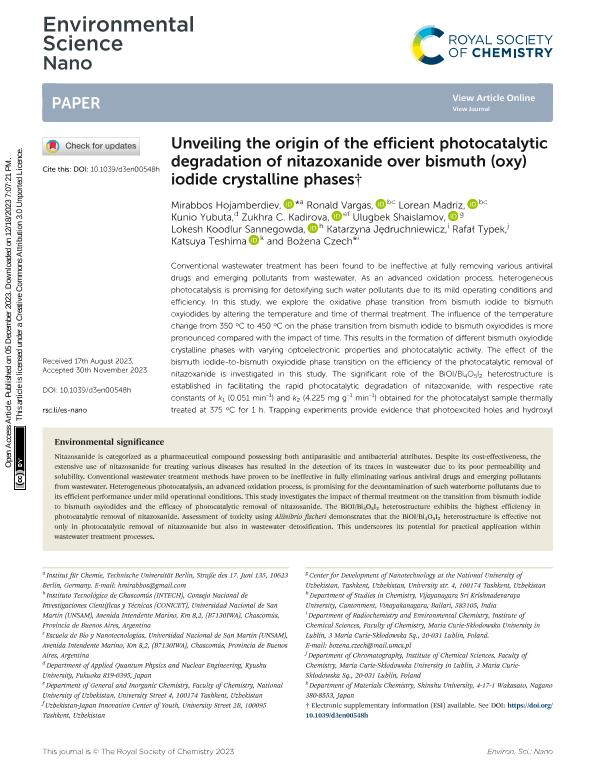Mostrar el registro sencillo del ítem
dc.contributor.author
Hojamberdiev, Mirabbos

dc.contributor.author
Vargas Balda, Ronald Eduardo

dc.contributor.author
Madriz Ruiz, Lorean Mercedes

dc.contributor.author
Yubuta, Kunio
dc.contributor.author
Kadirova, Zukhra C.
dc.contributor.author
Shaislamov, Ulugbek
dc.contributor.author
Sannegowda, Lokesh Koodlur
dc.contributor.author
Jędruchniewicz, Katarzyna
dc.contributor.author
Typek, Rafał
dc.contributor.author
Teshima, Katsuya
dc.contributor.author
Czech, Bożena
dc.date.available
2024-03-12T14:07:57Z
dc.date.issued
2023-12
dc.identifier.citation
Hojamberdiev, Mirabbos; Vargas Balda, Ronald Eduardo; Madriz Ruiz, Lorean Mercedes; Yubuta, Kunio; Kadirova, Zukhra C.; et al.; Unveiling the origin of the efficient photocatalytic degradation of nitazoxanide over bismuth (oxy)iodide crystalline phases; Royal Society of Chemistry; Environmental Science: Nano; 11; 1; 12-2023; 336-350
dc.identifier.issn
2051-8153
dc.identifier.uri
http://hdl.handle.net/11336/230217
dc.description.abstract
Conventional wastewater treatment has been found to be ineffective at fully removing various antiviral drugs and emerging pollutants from wastewater. As an advanced oxidation process, heterogeneous photocatalysis is promising for detoxifying such water pollutants due to its mild operating conditions and efficiency. In this study, we explore the oxidative phase transition from bismuth iodide to bismuth oxyiodides by altering the temperature and time of thermal treatment. The influence of the temperature change from 350 °C to 450 °C on the phase transition from bismuth iodide to bismuth oxyiodides is more pronounced compared with the impact of time. This results in the formation of different bismuth oxyiodide crystalline phases with varying optoelectronic properties and photocatalytic activity. The effect of the bismuth iodide-to-bismuth oxyiodide phase transition on the efficiency of the photocatalytic removal of nitazoxanide is investigated in this study. The significant role of the BiOI/Bi4O5I2 heterostructure is established in facilitating the rapid photocatalytic degradation of nitazoxanide, with respective rate constants of k1 (0.051 min−1) and k2 (4.225 mg g−1 min−1) obtained for the photocatalyst sample thermally treated at 375 °C for 1 h. Trapping experiments provide evidence that photoexcited holes and hydroxyl radicals play a crucial role in the photocatalytic degradation of nitazoxanide. The photodegradation of nitazoxanide in aqueous solution over crystalline bismuth (oxy)iodide proceeds via hydrolysis into acetylsalicylic acid and the respective aminonitrothiazol, followed by the deacetylation and decarboxylation processes. Molecular dynamics simulation confirms that the high photocatalytic activity of BiOI/Bi4O5I2 is correlated to the higher adsorption energy due to the formation of a network of close contacts (<3.5 Å) between nitazoxanide molecules and iodine atoms.
dc.format
application/pdf
dc.language.iso
eng
dc.publisher
Royal Society of Chemistry

dc.rights
info:eu-repo/semantics/openAccess
dc.rights.uri
https://creativecommons.org/licenses/by/2.5/ar/
dc.subject
Nitazoxanide
dc.subject
Bismuth (oxy) iodide
dc.subject
Photocatalysis
dc.subject.classification
Físico-Química, Ciencia de los Polímeros, Electroquímica

dc.subject.classification
Ciencias Químicas

dc.subject.classification
CIENCIAS NATURALES Y EXACTAS

dc.title
Unveiling the origin of the efficient photocatalytic degradation of nitazoxanide over bismuth (oxy)iodide crystalline phases
dc.type
info:eu-repo/semantics/article
dc.type
info:ar-repo/semantics/artículo
dc.type
info:eu-repo/semantics/publishedVersion
dc.date.updated
2024-03-11T11:42:17Z
dc.identifier.eissn
2051-8161
dc.journal.volume
11
dc.journal.number
1
dc.journal.pagination
336-350
dc.journal.pais
Reino Unido

dc.journal.ciudad
Londres
dc.description.fil
Fil: Hojamberdiev, Mirabbos. Technishe Universitat Berlin; Alemania
dc.description.fil
Fil: Vargas Balda, Ronald Eduardo. Universidad Nacional de San Martín; Argentina. Consejo Nacional de Investigaciones Científicas y Técnicas. Centro Científico Tecnológico Conicet - La Plata. Instituto de Investigaciones Biotecnológicas. Universidad Nacional de San Martín. Instituto de Investigaciones Biotecnológicas; Argentina
dc.description.fil
Fil: Madriz Ruiz, Lorean Mercedes. Universidad Nacional de San Martín; Argentina. Consejo Nacional de Investigaciones Científicas y Técnicas. Centro Científico Tecnológico Conicet - La Plata. Instituto de Investigaciones Biotecnológicas. Universidad Nacional de San Martín. Instituto de Investigaciones Biotecnológicas; Argentina
dc.description.fil
Fil: Yubuta, Kunio. Kyushu University; Japón
dc.description.fil
Fil: Kadirova, Zukhra C.. National University of Uzbekistan; Uzbekistán. Tashkent State Technical University; Uzbekistán
dc.description.fil
Fil: Shaislamov, Ulugbek. National University Of Uzbekistan; Uzbekistán
dc.description.fil
Fil: Sannegowda, Lokesh Koodlur. Vijayanagara Sri Krishnadevaraya University; India
dc.description.fil
Fil: Jędruchniewicz, Katarzyna. Maria Curie-Skłodowska University in Lublin; Polonia
dc.description.fil
Fil: Typek, Rafał. Maria Curie-Skłodowska University in Lublin; Polonia
dc.description.fil
Fil: Teshima, Katsuya. Shinshu University; Japón
dc.description.fil
Fil: Czech, Bożena. Maria Curie-Skłodowska University in Lublin; Polonia
dc.journal.title
Environmental Science: Nano
dc.relation.alternativeid
info:eu-repo/semantics/altIdentifier/doi/http://dx.doi.org/10.1039/d3en00548h
dc.relation.alternativeid
info:eu-repo/semantics/altIdentifier/url/https://pubs.rsc.org/en/content/articlelanding/2024/en/d3en00548h
Archivos asociados
